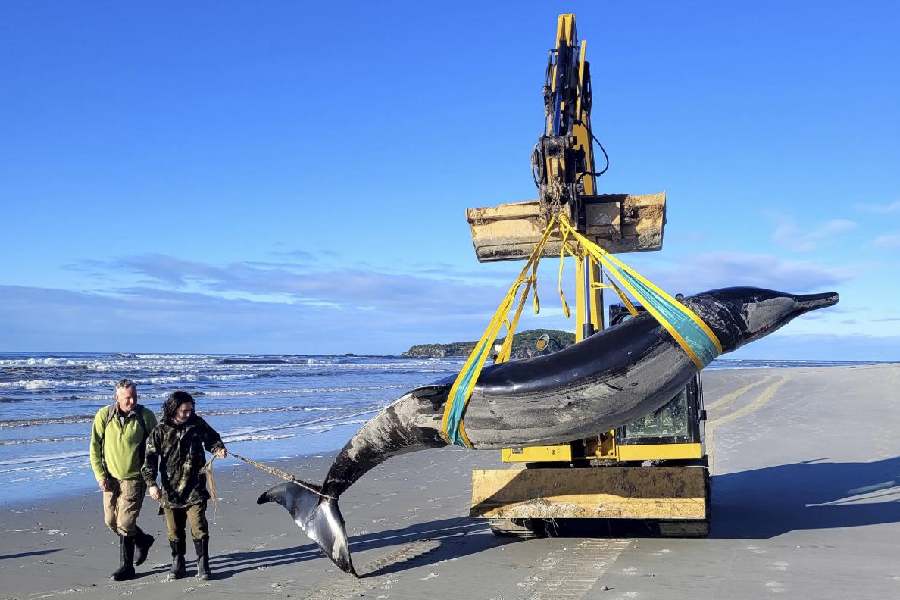As a hot spot for whale and dolphin strandings, residents of New Zealand are used to finding large sea creatures beached on their shores. But the creature that washed up on a beach in the nation’s south earlier this month — about 5 metres long, distinctively coloured, its teeth snapped off — was no ordinary whale.
Scientists believe it is a carcass of the world’s rarest whale, so elusive that it has never been documented alive.
Just six other specimens of the creature, known as a spade-toothed whale, exist — skeletal samples and carcasses found decades apart over 150 years. Until 2010, scientists didn’t even know what the whale looked like. Still, almost nothing is known about the species, including how many of the whales exist, what they eat and how they behave.
This carcass, which came to the attention of local officials on July 4 after washing ashore near the mouth of the Taieri River in Otago, in the nation’s South Island, presents an unprecedented opportunity. It was discovered quickly and put into a freezer, in such a state that scientists could dissect a specimen for the first time.
“Everything we look at will be new to science,” Anton van Helden, an adviser on marine species for New Zealand’s Department of Conversation and an expert in spade-toothed whales, said in an interview on Tuesday.
The conservation agency announced the discovery on Monday, noting that samples from the whale had been sent for DNA testing to confirm its identity.
But Van Helden, who has studied the species for 35 years, said he was “100 per cent confident” that it was a spade-toothed whale based on its distinctive colouring, the placement of its teeth and the shape of its jaw.
The species is a kind of beaked whale, in itself a mysterious category of mammal. Beaked whales spend much of their time diving in deep waters, and some species spend only an estimated five per cent of their time coming up to the surface for air, van Helden said, making it difficult for scientists to study them. In 2002, van Helden led a team of scientists who confirmed that the spade-toothed whale was a unique species, using three sets of skeletal remains collected in New Zealand and Chile between the 1870s and 1990s — some which had been misclassified or overlooked.
The species was first identified in 1874, using a jawbone and two tusked teeth collected from Pitt Island, New Zealand.
But because no more specimens of the species were found, scientists misclassified it as another species of beaked whale, called the strap-toothed whale.
A second sample was collected in 1950 from New Zealand’s White Bay but was kept in a university’s museum for decades without being identified — until van Herden stumbled upon it by accident. Another skull was discovered in Robinson Crusoe Island off Chile by scientists who, unaware of the two New Zealand samples, determined in 1995 that their skull belonged to a new species.
Van Herden and his team used DNA testing to determine that all three samples belonged to the same species, and “resurrected” the spade-toothed whale in 2002, he said. In 2010, a mother and calf washed ashore in New Zealand — the first intact specimens known to scientists — but were misidentified and buried before they could be examined. Still, they allowed scientists to begin to describe the whale’s appearance for the first time. Another stranding in New Zealand in 2017 helped solidify that description.
Before they can dissect the frozen whale carcass, scientists will have to hold discussions with the local Indigenous Maori people, who regard whales as sacred.
These talks will likely take a long time because of the whale’s rarity, a statement from the department of conservation said.
Earlier this year, indigenous leaders in New Zealand, Tahiti and the Cook Islands signed a treaty that recognised whales as legal persons.
If scientists are able to dissect the carcass, that could shed more light on their biology and how they differ from other beaked whales, Van Herden said.
The contents of its stomach could provide information on their diets and which
parts of the ocean they live
in.
“There’s a world of possibilities in terms of what we can uncover,” Van Herden said.
New York Times News Service










